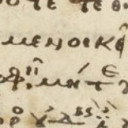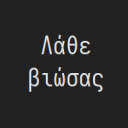The Wreathed Figure In Blue - Epicurus? Democritus? Someone Else?
-
-
Here's a new one:
This author floats the idea that this is Diogenes Laertius welcoming us into his Lives, in which he is writing:
https://risingtidefoundation.net/2020/12/08/the…phers-explored/
PS I'm not convinced by his argument. But at least it's another perspective. Having skimmed the articles 3 parts, he doesn't seem to include Epicurus which seems odd if we're using Laertius's Lives as the guide to the painting. Laertius devoted the final entire chapter to him!
-
Laurel wreathes tend to identify poets, so this symbolic allusion would not have been an effective way to express Epicurus: If this Renaissance artist's intention were to depict Epicurus, a symbol of poetry may not have been the first object an artist would have employed to identify an anti-superstitious proto-physicist.
For example: Danté Alighieri is almost exclusively depicted with a laurel wreath on his head. If I the context weren't Athens, I'd say that "Danté" would be a pretty safe guess to identify the figure, especially with the cherub; however, Raphael would have been very familiar with Danté's slender portrait with sharp cheekbones and a pointed chin.
It could be Lucretius: De Rerum Natura was spreading amongst educated circles; Lucretius would have been correctly identified as a "poet", and, symbolically, Raphael would have identified Lucretius as a Roman male, who, by default, are painted without beards when contrasted with Greeks (unless a bust is known like Marcus Aurelius).
It would seem that Lucretius' portrait was, perhaps, more unknown than Epicurus', so Lucretius should be a more likely candidate for the identity of the the "chubby, non-Greek-looking guy" than Epicurus, especially considering that we have a tall, bearded, Greek man with something similar to a bowl cut, painted with a strong brow in the background, who is a much better candidate in all regards for Epicurus.
Though, I'm not sure that the cherub, helping the figure hold up the book is consistent. The cherub, working with a poet to hold an epic would indicate that the poem were divinely inspired. I'm not sure that would have been the right message for a book that opens with a hymn to Venus. Then again, that's the bottom-line of the entire painting: that Greco-Roman pagans were on the right track to truth, but the wrong train.
The identity of this figure will have to cohere with the following imagery: (1) a uniquely chubby character who, (2) is not bearded, (3) is wearing a poet's laurel, (4) their work is being supported by a cherub, and (5) their shoulders are being physically massaged by dark-haired, downward-looking person behind him. The figure is well-fed and tranquil, smiling as a companion massages their shoulders, the very stereotype of a hedonist.
Given my assumption that Raphael didn't know what Lucretius looked like, I think this character, symbolically, in terms of imagery that Renaissance artists were regularly employing to convey meaning, better fits LUCRETIUS than Epicurus.
Even if he had seen the cartoon of Lucretius' profile, it would still have been appropriate to make the choice to remove his beard and add weight to his cheeks, arms, and neck to emphasize the archetype of a Roman Hedonist.
-
OK so he's the ONLY figure in the fresco with a laurel wreath. The suggestion that laurel wreaths are identified with poets would go a long way toward helping with the identity of this figure if we are confident of that association.
-
Quote
OK so he's the ONLY figure in the fresco with a laurel wreath. The suggestion that laurel wreaths are identified with poets would go a long way toward helping with the identity of this figure if we are confident of that association.
It might...except that its not a laurel wreath! Bay Laurel is indeed associated with poets. But this is an oak wreath.
-
Joshua does that appear to be a laurel wreath to you on Dante's head (above)? So the laurel is distinquished by somewhat pointed longer leaves all going in the same direction? https://en.wikipedia.org/wiki/Laurel_wreath
Is there a known association of someone/something with oak wreaths?
-
Don -- I note in that article you linked this passage below. I haven't yet tried to get a timeline on availability of Diogenes Laertius' biographies but this would indicate "widespread" and extensive knowledge of Epicurean philosophy by 1433 - which I gather is approximately the same time Greenblatt pins to the "rediscovery" of Lucretius. That would seem quite a coincidence in timing, as if perhaps one fed into the other. I'm still thinking that there's little reason to think that DL (and thus the basics of Epicurean philosophy) was ever gone from fairly widespread circulation. If there was a single "encyclopedia" that a reputable monk or monastery would want in its collection, seems to me that DL would be it. (I'm trying to think like a librarian!
 )
) -
Yeah, I didn't think that looked like Laurel. Could it be grape leaves? Joshua says oak. There are three lobes on those leaves.
Here's a snip from WP:
"Different plants were dedicated to various gods: oak to Zeus, laurel to Apollo, herbs to Demeter, grapevine to Dionysos and myrtle to Aphrodite. Wreaths were also used to decorate the hermae, stone pillars surmounted with the head of a god or distinguished mortal."
Another:
-
Maple or common fig?
-
I like the idea that it is Grape leaves.
Is this figure is an Epicurean, something indicating wine would be appropriate.
It could be Oak as well, signifying the Father God, and the source of Wisdom, thus, reinforcing the divine nature of whatever truth the writer is inscribing, helped by a cherub.
I am surprised that Raphael painted an author, receiving inspiration from a cherub, and chose NOT to identify him as a poet (with Laurel leaves). That may also have been a missed opportunity, and not the best artistic choice that could have been employed.
Or it could be ambivalent. Rather than specifically identifying a "poet", or "defender or Rome", or "brave soldier", it may just indicate "a Roman to the 16th-century mind".
-
The thought occurred to me too that it could be fig leaves, but they look more like some kind of oak to me.
-
The oak wreath is also emblematic of a certain pope Julius II, who was a patron of the arts at this time.
-
JJ may have just solved it.
-
You think Julius II looks liked the wreathed figure in blue? He does seem to have carried some significant weight.
-
Oh, I think that's an interesting theory but I doubt Raphael would take a chance in poking any fun at Julius II. From what I've cleaned, he was a huge patron of the arts but also an irascible, volatile warrior with a short fuse.
-
Seems that often Irascible volatile warriors tend to like to have their images preserved for eternity, however. I have no opinion at this point; that's the kind of suggestion that would take a lot of exploration.
-
I think Julius fits right in.
He named himself for Julius Caesar, so between him being the Pope while this was painted, and him being an admirer of Imperial Rome, adorning him with Oak Leaves, placing a Cherub next to him, and having him carrying a book along with Plato, Aristotle, Parmenides, and Heraclitus seems to me to expression of respect or admiration, not derision.
Big picture, I'd be surprised if Julius II weren't in this. He would have been jazzed to have been included amongst the ancient philosophers whom he admired, and Raphael would have had motivation to patronize the Pope by including him among the greats.
-
My money is currently on grape leaves. Plus I just realized he's not writing in the book, he's reading. The hand closer to his head is getting the figure behind him. Might be old news, but new to me
-
I just realized he's not writing in the book, he's reading.
Sure about that?
-
Ah, good point. I see it now:
That hand is grabbing the figure's shoulder.
The figure, themself, is holding each end of the book. You're right.
-
Unread Threads
-
- Title
- Replies
- Last Reply
-
-

-
New Religious Landscape Study from Pew Research 29
- Don
February 26, 2025 at 10:40 PM - General Discussion
- Don
April 19, 2025 at 8:31 AM
-
- Replies
- 29
- Views
- 2.3k
29
-
-
-

-
Diogenes Laertius Book X - public domain translations 3
- TauPhi
April 16, 2025 at 9:10 AM - General Discussion
- TauPhi
April 18, 2025 at 7:19 AM
-
- Replies
- 3
- Views
- 227
3
-
-
-

-
"Voices From The Ancient World" Greek and Latin Reference Site
- Cassius
April 17, 2025 at 8:38 AM - General Discussion
- Cassius
April 17, 2025 at 8:38 AM
-
- Replies
- 0
- Views
- 137
-
-
-

-
Life Found Elsewhere? 7
- kochiekoch
April 17, 2025 at 6:10 AM - General Discussion
- kochiekoch
April 17, 2025 at 8:33 AM
-
- Replies
- 7
- Views
- 207
7
-
-
-

-
Must an Epicurean believe in gods? 14
- Rolf
April 15, 2025 at 5:24 PM - General Discussion
- Rolf
April 16, 2025 at 7:11 PM
-
- Replies
- 14
- Views
- 449
14
-

